Interested in learning about chords and how to use them in your music?
The major 7 chord is a popular chord that is used in a variety of music styles. In this article on Major 7 chords Guitar, we will explore the basic music theory behind the major 7 chords, as well as discuss some of the ways that you can use this chord in your own music.
By the end of this article, you will have a better understanding of how to use the major 7 chords in your own chord progressions. You will also have access to several charts containing major 7th-chord shapes that you can use in your own playing. Finally, we will list several popular songs and compositions that feature the major 7th chord prominently.
Read the complete article to learn more about Major 7 chords!
Major 7 Chords Guitar – Music Theory
Any 7th chord is formed by stacking thirds over a basic triad, resulting in a 7th of some kind. Hence they are quadads or chords with four distinct notes. A major 7th chord is a specific form of the 7th chord, where a Major third interval is added over a basic Major triad. Due to this, it is also sometimes referred to as the Major/Major chord, where the first Major denotes the major triad and the second Major signifies the Major 7th interval.
This means you have a major 3rd interval placed over the root note, followed by a minor third, with a major third interval stacked on top of it. So the intervals forming the Major 7th chords are R – M3 – m3 – M3, where M3 is a Major 3rd, and m3 a minor 3rd. Hence the chord notes are {0, 4, 7, 11} semitones away from the root.
The Major 7th chords are formed from the scale degrees 1 and 4 of any major key and the scale degrees 3 and 6 of the minor scale. The scale degree 5 of the major scale forms a major triad, also known as the Dominant chord. It results in a dominant seventh chord when the 7th note is added.
A dominant 7th chord has a minor 3rd interval stacked over the major triad. Hence the 7th note is a minor 7th for any dominant 7th chord.
Representation of the major 7 chords
The major 7 chords are represented by the symbols: maj7, M7, Δ7. For example, Dmaj7, Dm7, or DΔ7 for the DMajor7 chord.
Major 7th Chord Formula
The Chord formula for the major seventh chord is [1 3 5 7]. As you can see, the Major 7th note is added to the major triad [1 3 5]. For Example, consider the C Major scale with the scale notes {C D E F G A B}. Applying the above chord formula, we get the notes of the C Major chord as {C E G B}, which is formed by adding the B note over the C Major triad.
Notes in the Major Seventh chord
The 7th major chord with the notes of Western music as their root notes are shown in the table below and have the following notes.
| Chord Name | Root | M3 | P5 | M7 |
|---|---|---|---|---|
| CMaj7 Chord | C | E | G | B |
| C#Maj7 Chord | C# | E# (F) | G# | B# (C) |
| Dbmaj7 Chord | Db | F | Ab | C |
| DMaj7 Chord | D | F# | A | C# |
| D#Maj7 Chord | D# | F## (G) | A# | C## (D) |
| EbMaj7 Chord | Eb | G | Bb | D |
| EMaj7 Chord | E | G# | B | D# |
| FMaj7 Chord | F | A | C | E |
| F#Maj7 Chord | F# | A# | C# | E# (F) |
| GbMaj7 Chord | Gb | Bb | Db | F |
| GMaj7 Chord | G | B | D | F# |
| G#Maj7 Chord | G# | B# (C) | D# | F## (G) |
| AbMaj7 Chord | Ab | C | Eb | G |
| AMaj7 Chord | A | C# | E | G# |
| A#Maj7 Chord | A# | C## (D) | E# (F) | G## (A) |
| BbMaj7 Chord | Bb | D | F | A |
| BMaj7 Chord | B | D# | F# | A# |
Inversions of the Major 7th Chords
As you have seen in our article on chord inversions, all four-note chords have three inversions, with each of the three notes other than the original root note as the bass notes. So the three inversions of the Cmaj7 chord are shown below.
The 1st Inversion
The first inversion is created by shifting the root note of the regular major chord (the root position chord) up by one octave, forming the inverted chord as [3 5 7 1]. The first inversion of the Cmaj7 is {E G B C}, denoted as Cmaj7/E.
In the figured bass system, the Inversion is denoted by the chord name in Roman numeral followed by 6/5. So, the tonic chord in 1st inversion is denoted by “I (6/5).“
The 2nd Inversion
The second inversion is formed by shifting the first two notes of the original chord one octave higher, forming the inverted chord as [5 7 1 3]. The perfect fifth is the lowest note in this chord voicing. The 2nd inversion of the Cmaj7 is {G B C E}, denoted as Cmaj7/G. The 2nd inversion is denoted by “4/3” in the figured bass systems, for example, “V 4/3”, for the second inversion of the V7 chord.
The 3rd Inversion
You need to shift the first three notes of the original chord up by one octave to get the 3rd inversion as [7 1 3 5]. The 3rd inversion of the Cmaj7 is {B C E G}, denoted as Cmaj7/B. The third inversion is denoted by “4/2” in the figured bass system. For example, “I (4/2),” for the 3rd inversion of the tonic chord.
Drop-N Major Seventh Chords
The nomenclature Drop-N requires you to lower the pitch of the Nth note from the highest (the top note) of any chord by one octave. The Drop-N allows you to play the notes of the four-note chords on four adjacent strings.
Drop-2 Major Seventh Chords
By the above logic, the Drop-2 Major 7 chord will have the chord formula [5 1 3 7}, as you need to lower the 2nd note from the top, the 5th note in the original chord [1 3 5 7} by one octave. So the drop-2 voicing for the Cmaj7 chord is {G C E B}.
Drop 3 Major Seventh Chords
In the same way, a Drop-3 chord requires you to lower the 3rd note by one octave, resulting in the chord formula [3 1 5 7]. The drop-3 voicing for the Cmaj7 chord is {E C G B}.
Drop 2 & 4 Major Seventh Chords
Drop 2 & 4 Major 7 chords have the chord formula [1 5 3 7], and the Drop 2 & 4 voicings for the Cmaj7 chord is {C G E B}.
7th Major Chord Shapes
There are many different ways to play the Major 7 chords on the guitar fretboard, including the open positions, movable closed chord shapes with the root notes on the 4th, 5th, & 6th strings, and movable barre chord shapes. Let us see them in detail in the following sections.
Open Position Shapes
The open position shapes for the 7th major guitar chords are shown in the below chord diagrams for the natural notes.
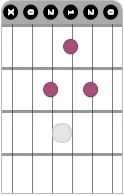
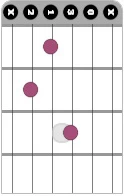
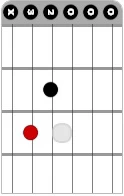
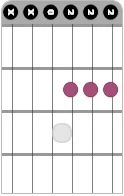
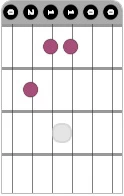
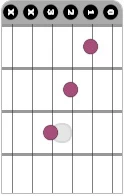
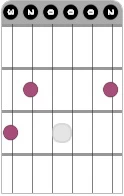
Movable Closed Shapes for Major 7th Chords
The below diagrams show the closed shapes with
- The root on the fourth string.
- The root on the fifth string.
- The root on the sixth string.
Each of these shapes can be moved down towards the neck to form the other Major 7 chords, as shown.
Root on the Fourth string.
The number on the pink mark is the finger to be used, while the number of the black circles shows the fret numbers for the notes.
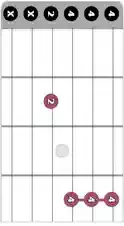
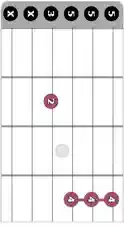
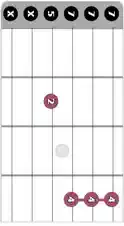
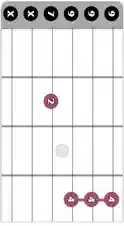
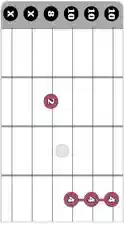
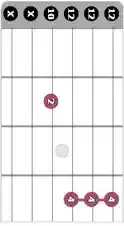
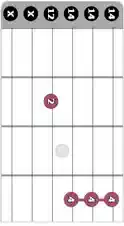
Root on the Fifth string.
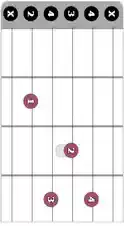
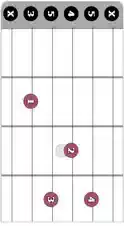
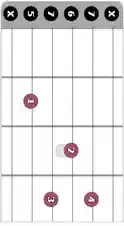
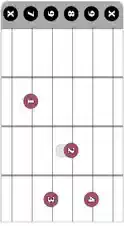
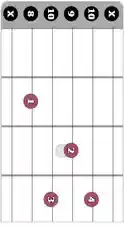
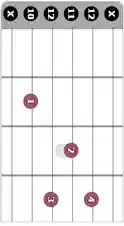
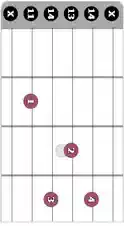
Root on the Sixth string.
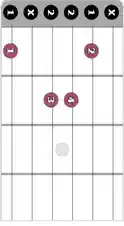
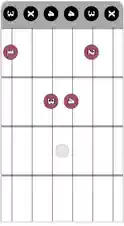
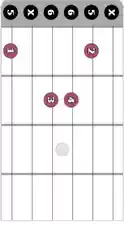
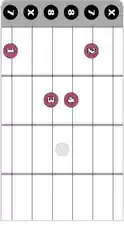
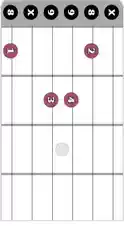
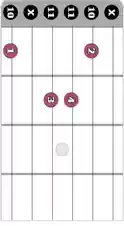
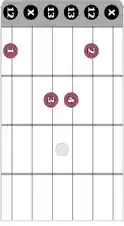
Movable barre shapes for major 7th chords
The below chord diagrams show the E and A movable shapes (barre) for playing the 7th major chords. Note the Root position in both these shapes. Moving the barre chords downwards results in the other major 7 chords.
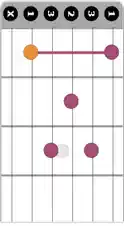
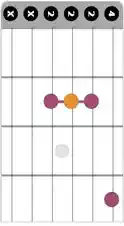
Popular Songs and Compositions using the Major 7 chords
In the early part of the 20th century, the major 7 chords were frequently used in jazz and jazz-influenced genres like traditional pop, bossa nova, and easy listening.
In the 1970s, they became prevalent in pervading soul, country rock, soft rock, jazz-rock, funk, and disco. Some popular songs and compositions using the major 7th chords are shown in the list below.
- “Autumn Leaves” by Joseph Kosma.
- “One of these nights” by the Eagles.
- “This boy” by the Beatles.
- “Colour my World” by Chicago.
- “The right thing to do” by Carly Simon.
- “Stairway to Heaven” by Led Zeppelin.
- “Under the Bridge” by Red Hot Chili Peppers.
Conclusion
Now that you know how to play major 7 chords on the guitar, it’s time to start putting them into your songs. The sky is the limit when it comes to chord progressions, so get creative and have fun experimenting with different combinations of major 7th chords. If you have any questions or need clarification on anything, please leave a comment below, and we’ll be happy to help.
